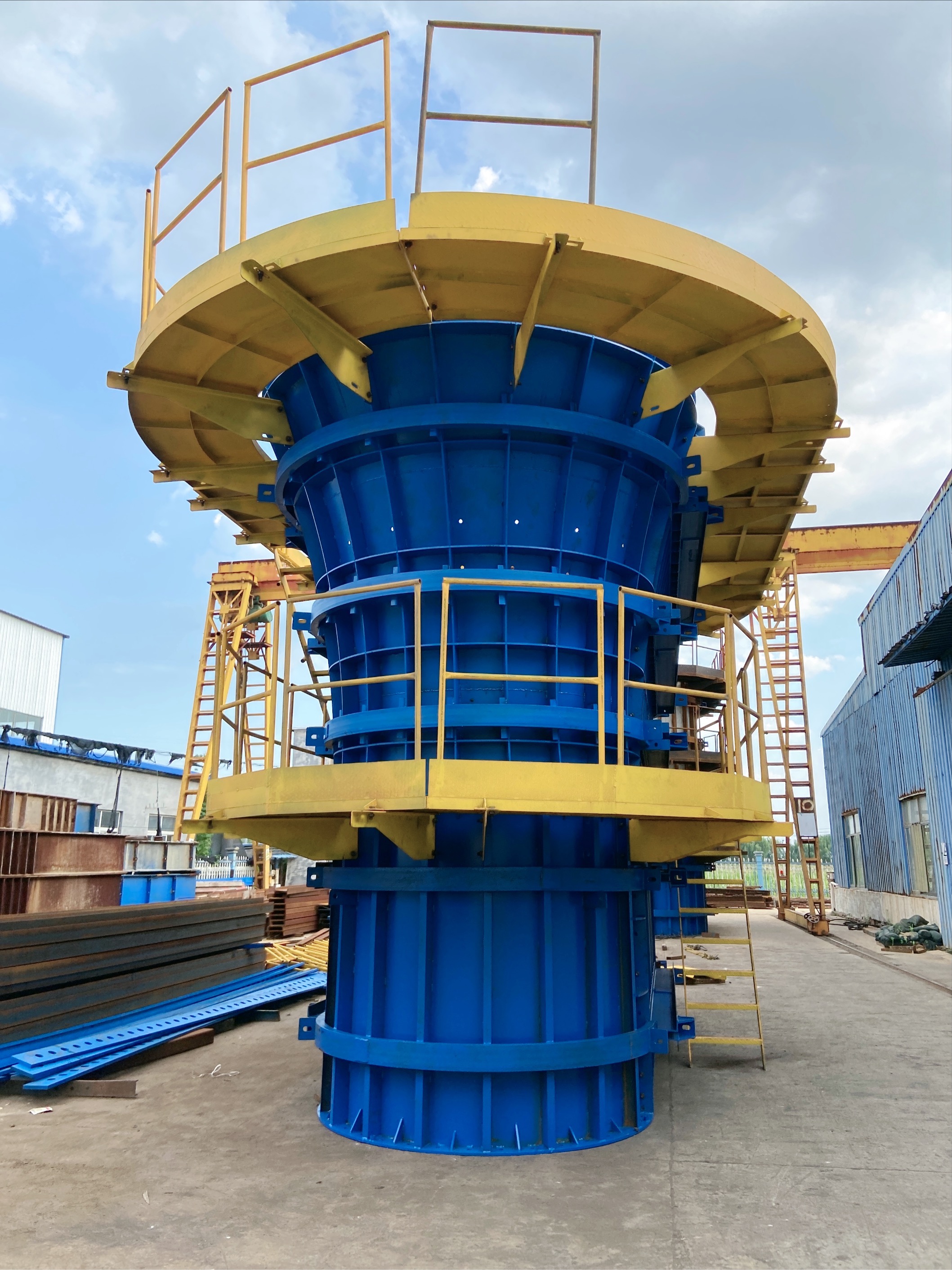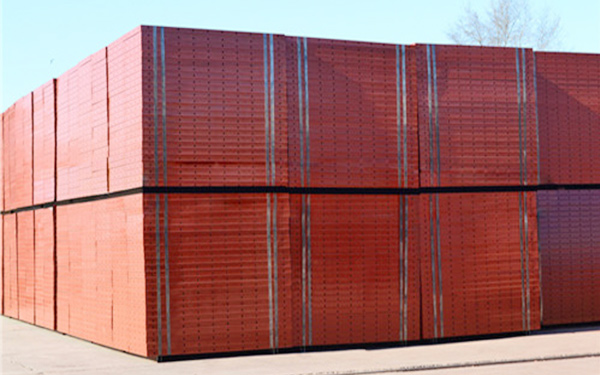Current position:
Home
News home
Industry News
Nearby steel formwork manufacturers: What are the main functions of steel formwork?
Nearby steel formwork manufacturers: What are the main functions of steel formwork?
source:Shandong Tianhong Heavy Industry Co., Ltd
Abstract:
Steel formwork is a temporary support structure used for concrete pouring and forming in construction engineering. Its core function is to provide shape and support for concrete, ensuring that it meets design requirements...
1、 The main function of steel formwork
Shaped concrete structure
As a mold, steel formwork provides precise geometric shapes for concrete (such as walls, beams, columns, floors, etc.) to ensure that the structure meets design requirements.
Suitable for complex or high-precision structures such as bridges, tunnels, large factories, etc.
Carrying construction loads
During the concrete pouring process, steel formwork needs to withstand the weight of the concrete, the weight of construction equipment, and the dynamic loads generated by worker operations. Its high strength and rigidity can effectively prevent deformation or collapse.
Improve construction quality
The surface of the steel formwork is smooth and the joints are tight. The surface of the poured concrete has high flatness, which can directly achieve the effect of "plain concrete" and reduce the cost of plastering and repairing in the later stage.
Accelerate construction progress
Modular design supports quick assembly and disassembly, especially suitable for repetitive projects (such as high-rise standard floors), shortening the construction period.
Ensure construction safety
Steel formwork has strong stability and can reduce safety risks caused by formwork deformation or fracture during the pouring process.
2、 The core function of steel formwork
High strength and durability
Made of steel (Q235 or Q345), it has excellent compressive and bending resistance, can withstand high loads and repeated use, and has a lifespan of hundreds of times or more.
Accurate size control
Industrial production ensures small template size errors (within ± 1mm), suitable for projects with high precision requirements (such as prefabricated buildings).
Repeated turnover and use
Steel formwork can be reused 300-500 times or more, with a lower long-term cost than wooden formwork, making it suitable for large-scale or long-term projects.
Weather resistance and adaptability
After surface galvanizing or painting treatment, it is corrosion-resistant and heat-resistant, and can be used stably in humid, rainy, or temperature difference environments.
Environmental Protection and Resource Conservation
Steel can be 100% recycled and reused, reducing wood consumption and construction waste, in line with the concept of green construction.
3、 Typical application scenarios of steel formwork
Advantages of specific application functions for engineering types
Bridge engineering bridge piers, box girders, and bridge deck pouring have high bearing capacity and deformation resistance, ensuring the stability of large volume concrete forming
Modular assembly of shear walls, core tubes, and standard floor slabs in high-rise buildings, fast turnover, and reduced overall costs
Accurate dimensional control of large equipment foundations and prefabricated components in industrial plants to meet the installation requirements of heavy equipment
Water conservancy engineering dams, culverts, and gate structures are corrosion-resistant, leak resistant, and suitable for long-term humid environments
4、 Limitations and countermeasures of steel formwork
Heavy weight and inconvenient handling
It requires the assistance of tower cranes or forklifts for installation, resulting in high labor costs.
Countermeasure: Optimize the template block design and use lightweight steel (such as thin-walled steel).
High initial investment
The unit price of steel formwork is 5-10 times that of wooden formwork, making it uneconomical for small-scale projects.
Countermeasure: Rent steel formwork or use it in combination with aluminum formwork to reduce upfront costs.
Lack of flexibility
Difficult to adjust after finalization, customized templates are required for irregular structures.
Countermeasure: Use wooden templates or 3D printing technology to handle complex local shapes.
5、 The future development trend of steel formwork
Intelligent upgrade
Introducing BIM technology to optimize template design and achieve digital assembly and construction simulation.
Lightweight materials
Developing high-strength lightweight steel (such as alloy steel) to reduce template weight and improve manual operation efficiency.
green construction
Promote the combination of steel formwork and renewable materials to further reduce carbon emissions.
summarize
Steel formwork has become the preferred formwork for large-scale engineering and standardized construction due to its high strength, high precision, and long service life. Its core value lies in reducing overall costs through repeated use, while ensuring the quality of concrete molding and construction safety. In practical applications, it is necessary to make reasonable choices based on project scale, structural characteristics, and budget, and when necessary, collaborate with other templates to maximize benefits.
Shaped concrete structure
As a mold, steel formwork provides precise geometric shapes for concrete (such as walls, beams, columns, floors, etc.) to ensure that the structure meets design requirements.
Suitable for complex or high-precision structures such as bridges, tunnels, large factories, etc.
Carrying construction loads
During the concrete pouring process, steel formwork needs to withstand the weight of the concrete, the weight of construction equipment, and the dynamic loads generated by worker operations. Its high strength and rigidity can effectively prevent deformation or collapse.
Improve construction quality
The surface of the steel formwork is smooth and the joints are tight. The surface of the poured concrete has high flatness, which can directly achieve the effect of "plain concrete" and reduce the cost of plastering and repairing in the later stage.
Accelerate construction progress
Modular design supports quick assembly and disassembly, especially suitable for repetitive projects (such as high-rise standard floors), shortening the construction period.
Ensure construction safety
Steel formwork has strong stability and can reduce safety risks caused by formwork deformation or fracture during the pouring process.
2、 The core function of steel formwork
High strength and durability
Made of steel (Q235 or Q345), it has excellent compressive and bending resistance, can withstand high loads and repeated use, and has a lifespan of hundreds of times or more.
Accurate size control
Industrial production ensures small template size errors (within ± 1mm), suitable for projects with high precision requirements (such as prefabricated buildings).
Repeated turnover and use
Steel formwork can be reused 300-500 times or more, with a lower long-term cost than wooden formwork, making it suitable for large-scale or long-term projects.
Weather resistance and adaptability
After surface galvanizing or painting treatment, it is corrosion-resistant and heat-resistant, and can be used stably in humid, rainy, or temperature difference environments.
Environmental Protection and Resource Conservation
Steel can be 100% recycled and reused, reducing wood consumption and construction waste, in line with the concept of green construction.
3、 Typical application scenarios of steel formwork
Advantages of specific application functions for engineering types
Bridge engineering bridge piers, box girders, and bridge deck pouring have high bearing capacity and deformation resistance, ensuring the stability of large volume concrete forming
Modular assembly of shear walls, core tubes, and standard floor slabs in high-rise buildings, fast turnover, and reduced overall costs
Accurate dimensional control of large equipment foundations and prefabricated components in industrial plants to meet the installation requirements of heavy equipment
Water conservancy engineering dams, culverts, and gate structures are corrosion-resistant, leak resistant, and suitable for long-term humid environments
4、 Limitations and countermeasures of steel formwork
Heavy weight and inconvenient handling
It requires the assistance of tower cranes or forklifts for installation, resulting in high labor costs.
Countermeasure: Optimize the template block design and use lightweight steel (such as thin-walled steel).
High initial investment
The unit price of steel formwork is 5-10 times that of wooden formwork, making it uneconomical for small-scale projects.
Countermeasure: Rent steel formwork or use it in combination with aluminum formwork to reduce upfront costs.
Lack of flexibility
Difficult to adjust after finalization, customized templates are required for irregular structures.
Countermeasure: Use wooden templates or 3D printing technology to handle complex local shapes.
5、 The future development trend of steel formwork
Intelligent upgrade
Introducing BIM technology to optimize template design and achieve digital assembly and construction simulation.
Lightweight materials
Developing high-strength lightweight steel (such as alloy steel) to reduce template weight and improve manual operation efficiency.
green construction
Promote the combination of steel formwork and renewable materials to further reduce carbon emissions.
summarize
Steel formwork has become the preferred formwork for large-scale engineering and standardized construction due to its high strength, high precision, and long service life. Its core value lies in reducing overall costs through repeated use, while ensuring the quality of concrete molding and construction safety. In practical applications, it is necessary to make reasonable choices based on project scale, structural characteristics, and budget, and when necessary, collaborate with other templates to maximize benefits.
Disclaimer: The content provided on this website is for reference only (some information is sourced from the internet). The publication of content information is for the purpose of transmission and does not represent the views of this website. If the content involves copyright issues, please contact the website editor in a timely manner, and we will take appropriate measures to avoid unnecessary losses for both parties.
Related article
- Steel template manufacturers supply for rent: How to deal with steel template size accuracy that is not up to standard? 双语对照 笔记
- Customization of steel formwork specifications: What are the installation steps for steel formwork?
- Manufacturers of composite steel formwork: How to evaluate the corrosion rate of the formwork?
- Pulling out Mountains and Rivers for Win Win - Jining Tianli Employees Celebrate National Day Holiday with Tug of War Competition
- Composite bridge steel formwork processing manufacturer: How to check the dimensional accuracy after steel formwork correction?
- Composite steel formwork rental: What buildings are steel formwork mainly used in?
- Customized rental of construction steel formwork: How to ensure the installation accuracy of steel formwork?
- Renting steel formwork manufacturers: How much does the material of steel formwork affect the price?
- Large scale steel formwork manufacturers: What are the advantages and disadvantages of galvanizing treatment for steel formwork?
- Processing custom steel formwork factory: About rust prevention treatment methods and precautions for steel formwork
- Rental of construction steel formwork: How to choose suitable steel formwork materials?
- Customized specifications for steel formwork: What factors need to be considered in calculating the weight of steel formwork?
Hot article

- T梁模版
- Pulling out Mountains and Rivers for Win Win - Jining Tianli Employees Celebrate National Day Holiday with Tug of War Competition
- 力“拔”山兮,“河”作共赢——济宁天力员工欢度国庆假期之拔河比赛
- Pulling out Mountains and Rivers for Win Win - Jining Tianli Employees Celebrate National Day Holiday with Tug of War Competition
- Pulling out Mountains and Rivers for Win Win - Jining Tianli Employees Celebrate National Day Holiday with Tug of War Competition
- Pulling out Mountains and Rivers for Win Win - Jining Tianli Employees Celebrate National Day Holiday with Tug of War Competition
- Pulling out Mountains and Rivers for Win Win - Jining Tianli Employees Celebrate National Day Holiday with Tug of War Competition
Recommended article

Customized rental of construction steel formwork: How to prevent and deal with loose joints in steel formwork?

Customized rental of steel formwork: What are the dimensions, specifications, and models of steel formwork?
- Customized rental of construction steel formwork: How to prevent and deal with loose joints in steel formwork?
- Customized rental of steel formwork: What are the dimensions, specifications, and models of steel formwork?
- Steel formwork manufacturer supply specifications: What are the applicable fields for steel formwork
- 力“拔”山兮,“河”作共赢——济宁天力员工欢度国庆假期之拔河比赛
- Pulling out Mountains and Rivers for Win Win - Jining Tianli Employees Celebrate National Day Holiday with Tug of War Competition
- Pulling out Mountains and Rivers for Win Win - Jining Tianli Employees Celebrate National Day Holiday with Tug of War Competition
- Pulling out Mountains and Rivers for Win Win - Jining Tianli Employees Celebrate National Day Holiday with Tug of War Competition
- Pulling out Mountains and Rivers for Win Win - Jining Tianli Employees Celebrate National Day Holiday with Tug of War Competition



